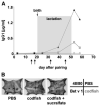Anti-ulcer treatment during pregnancy induces food allergy in mouse mothers and a Th2-bias in their offspring
- PMID: 17227952
- PMCID: PMC2999745
- DOI: 10.1096/fj.06-7223com
Anti-ulcer treatment during pregnancy induces food allergy in mouse mothers and a Th2-bias in their offspring
Abstract
The treatment of dyspeptic disorders with anti-acids leads to an increased risk of sensitization against food allergens. As these drugs are taken by 30-50% of pregnant women due to reflux and heartburn, we aimed here to investigate the impact of maternal therapy with anti-acids on the immune response in the offspring in a murine model. Codfish extract as model allergen was fed with or without sucralfate, an anti-acid drug, to pregnant BALB/c mice during pregnancy and lactation. These mothers developed a codfish-specific allergic response shown as high IgG1 and IgE antibody levels and positive skin tests. In the next step we analyzed whether this maternal sensitization impacts a subsequent sensitization in the offspring. Indeed, in stimulated splenocytes of these offspring we found a relative Th2-dominance, because the Th1- and T-regulatory cytokines were significantly suppressed. Our data provide evidence that the anti-acid drug sucralfate supports sensitization against food in pregnant mice and favors a Th2-milieu in their offspring. From these results we propose that anti-acid treatment during pregnancy could be responsible for the increasing number of sensitizations against food allergens in young infants.
Figures





Similar articles
-
The impact of aluminium in acid-suppressing drugs on the immune response of BALB/c mice.Clin Exp Allergy. 2007 Oct;37(10):1566-73. doi: 10.1111/j.1365-2222.2007.02813.x. Epub 2007 Sep 10. Clin Exp Allergy. 2007. PMID: 17850381
-
Anti-acids lead to immunological and morphological changes in the intestine of BALB/c mice similar to human food allergy.Exp Toxicol Pathol. 2008 Aug;60(4-5):337-45. doi: 10.1016/j.etp.2008.03.004. Epub 2008 Jun 4. Exp Toxicol Pathol. 2008. PMID: 18524557
-
Aluminium per se and in the anti-acid drug sucralfate promotes sensitization via the oral route.Allergy. 2009 Jun;64(6):890-7. doi: 10.1111/j.1398-9995.2008.01933.x. Epub 2009 Feb 5. Allergy. 2009. PMID: 19210370
-
Allergic sensitization and allergen exposure during pregnancy favor the development of atopy in the neonate.Int Arch Allergy Immunol. 2001 Jan-Mar;124(1-3):193-6. doi: 10.1159/000053708. Int Arch Allergy Immunol. 2001. PMID: 11306966
-
Influences of Maternal Factors Over Offspring Allergies and the Application for Food Allergy.Front Immunol. 2019 Aug 23;10:1933. doi: 10.3389/fimmu.2019.01933. eCollection 2019. Front Immunol. 2019. PMID: 31507589 Free PMC article. Review.
Cited by
-
Potential immunological consequences of pharmacological suppression of gastric acid production in patients with multiple sclerosis.BMC Med. 2012 Jun 7;10:57. doi: 10.1186/1741-7015-10-57. BMC Med. 2012. PMID: 22676575 Free PMC article. Review.
-
Prenatal exposure to acid-suppressant medications and the risk of recurrent wheeze at 3 years of age in children with a history of severe bronchiolitis.J Allergy Clin Immunol Pract. 2019 Sep-Oct;7(7):2422-2424.e4. doi: 10.1016/j.jaip.2019.02.039. Epub 2019 Mar 13. J Allergy Clin Immunol Pract. 2019. PMID: 30878709 Free PMC article. No abstract available.
-
Environmental and infectious factors in eosinophilic esophagitis.Best Pract Res Clin Gastroenterol. 2015 Oct;29(5):721-729. doi: 10.1016/j.bpg.2015.06.008. Epub 2015 Jul 17. Best Pract Res Clin Gastroenterol. 2015. PMID: 26552771 Free PMC article. Review.
-
Food allergy: Insights into etiology, prevention, and treatment provided by murine models.J Allergy Clin Immunol. 2014 Feb;133(2):309-17. doi: 10.1016/j.jaci.2013.12.1045. J Allergy Clin Immunol. 2014. PMID: 24636470 Free PMC article. Review.
-
Acid suppressant medications and the risk of allergic diseases.Expert Rev Clin Immunol. 2018 Sep;14(9):771-780. doi: 10.1080/1744666X.2018.1512405. Epub 2018 Aug 24. Expert Rev Clin Immunol. 2018. PMID: 30113236 Free PMC article.
References
-
- Sicherer SH, Munoz-Furlong A, Sampson HA. Prevalence of seafood allergy in the United States determined by a random telephone survey. J. Allergy. Clin. Immunol. 2004;114:159–165. - PubMed
-
- Venter C, Pereira B, Grundy J, Clayton CB, Roberts G, Higgins B, Dean T. Incidence of parentally reported and clinically diagnosed food hypersensitivity in the first year of life. J. Allergy. Clin. Immunol. 2006;117:1118–1124. - PubMed
-
- Cogswell JJ. Influence of maternal atopy on atopy in the offspring. Clin. Exp. Allergy. 2000;30:1–3. - PubMed
-
- Schöll I, Untersmayr E, Bakos N, Roth-Walter F, Gleiss A, Boltz-Nitulescu G, Scheiner O, Jensen-Jarolim E. Antiulcer drugs promote oral sensitization and hypersensitivity to hazelnut allergens in BALB/c mice and humans. Am. J. Clin. Nutr. 2005;81:154–160. - PubMed
-
- Untersmayr E, Bakos N, Schöll I, Kundi M, Roth-Walter F, Szalai K, Riemer AB, Ankersmit HJ, Scheiner O, Boltz-Nitulescu G, Jensen-Jarolim E. Anti-ulcer drugs promote IgE formation toward dietary antigens in adult patients. FASEB J. 2005;19:656–658. - PubMed
Publication types
MeSH terms
Substances
Grants and funding
LinkOut - more resources
Full Text Sources
Other Literature Sources
Medical
Research Materials

